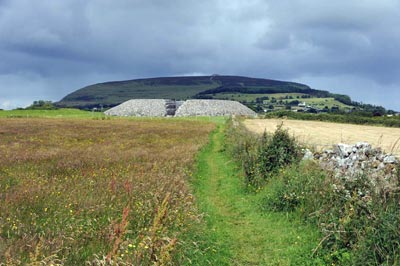In all the ancient Irish literature we find the connection of the gods with the raths and cairns perpetually insisted upon. The scene of the destruction of the Firbolg will be found to be a place of tombs, the metropolis of the Fomorian a place of tombs, and a place of tombs the sacred home of the Tuatha along the shores of the Boyne. The connection between the great raths and cairns and the gods is never really forgotten.
Standish O'Grady, Early Bardic Literature, 1879
Between 4000 and 2800 BCE the great megalithic monuments of Ireland were constructed. To the north of a line which divides the country from west-north-west to east-south-east, from Sligo to just south of Dublin, we find the monuments, that are today referred to as passage tombs. South of this line we find standing stones and stone circles, but it is the passage tombs that appear to have most captured the imagination during the seven and a half millennia that have passed since they were built.
The people who built these monuments left no written records so we can speculate but never know for sure, why they were built and what meaning they held for the people of the time. They were given the name 'passage tombs' by the early investigators who assumed they were purely burial chambers, a belief supported by the presence of cremated remains in many of the tombs, although there is no evidence to show that the remains are contemporary with the building of the monuments.
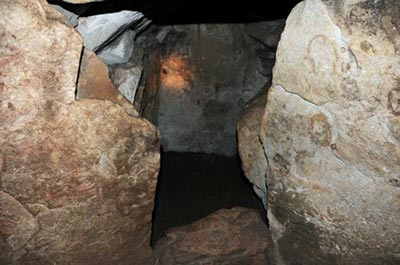
Chamber at Cairn T in Carnbane East, Loughcrew
There are around 230 known monuments of this class, many having been built on sites that had already become important to the society of the time. The majority are the cruciform shape which consists of a passage lined with orthostats, or large upright stones, leading to a central chamber which usually contains recesses, which often contained stone basins. The passage is constructed so that the chamber is dark, and light can only come in through the passage or special openings. In some cases a stone is in place to block the light and restrict it to certain times of the day and year. In tombs that have solar alignments there is sometimes a back stone over which the light passes.
Passage tombs in Ireland are usually found on top of a hill with an unobstructed view of the horizon from the front of the passage. Typically they consist of a round mound delimited by a kerb of stones, frequently decorated. The outside is usually decorated with quartz which in Irish is known as 'the stone of the sun'. Irish passage tombs are noted for their extensive art work, which is most often seen on tombs with solar alignments. There are many individual or small groups of tombs, but the bulk of them are found in four major sites, Carrowmore and Carrowkeel in Sligo and Brú na Bóinne and Loughcrew in the East. The most famous of these sites is the great mound at Newgrange in Brú na Bóinne.
Brú na Bóinne
The World Heritage Site Brú na Bóinne, in the bend of the Boyne River in Co. Meath, contains between thirty-five and forty tombs spread over a wide area, many of which have not yet been excavated. It contains three main complexes, Newgrange, Knowth and Dowth.
Newgrange
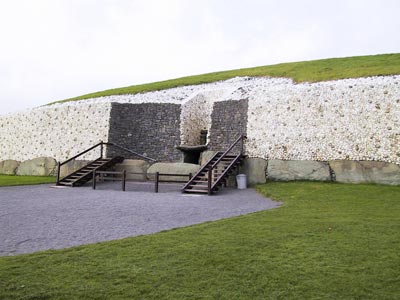
Entrance to the Monument at Newgrange
Newgrange (3200 BCE) is best known for its alignment to the Winter Solstice Sunrise. It has the cruciform shape of a long narrow passage that ends in a central inner chamber with three recesses. Over the entrance to the passage is a 90cm x 1m opening known as the Roofbox. Because the passage runs uphill, the roofbox is roughly at the same level as the floor of the inner chamber.
On the morning of the Winter Solstice (and three days either side) as the Sun rises in the south-east, the rays shine in through the roofbox, along the passage onto the floor of the inner chamber, which gradually lights up. As the Sun continues to rise, it darkens again. The whole process from the entry of the first ray back to total darkness is seventeen minutes. Apart from these few days around the Solstice (and electric lights), the inner chamber is in total darkness.
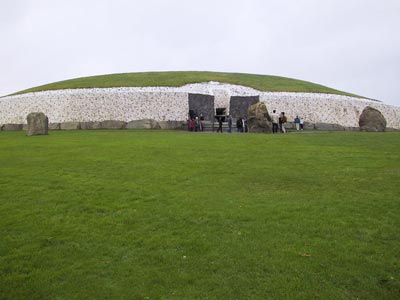
Monument at Newgrange
As Standish O'Grady pointed out, in the nineteenth century, all of the four cycles of Irish mythology abound with references to the passage tombs. Of all the sites, Newgrange appears most often in all four cycles, always being associated with a God of the Sun and with the concept of birth/rebirth or eternal life. It is the home of the immortal Tuatha de Danaan, the Lords of Light from the Mythological Cycle, and is described as a magnificent other worldly place where no one ever dies, a place of perpetual festivities and plenty.
Elcmar, the first of the Tuatha to inhabit the mound, was married to Boand, the divine personification of the river Boyne, whose source is the well of Segais, an Otherworld well which is the source of all wisdom and occult knowledge. The next inhabitant was the all powerful and omniscient Dagda, the most prominent of the ancient Irish gods. He was a god of wisdom and of the Sun. Dagda gains possession of the mound and sends Elcmar on an errand for a day that lasts nine months.
During this time he manages to impregnate Boand, and their son Óengus is born. Óengus's conception and birth takes place at this magical lengthening of the day at Newgrange, where the point at which days being to lengthen is dramatically marked at sunrise. Newgrange in the myths is often referred to as the Brú of Óengus, who is considered a personification of the day.
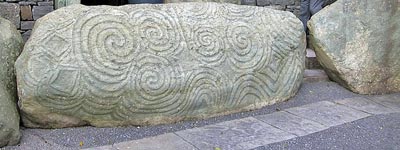
Newgrange Kerbstone K1 ~ The Entrance Stone
Cú Chulainn, from the Ulster Cycle is the son of a Sun god and is born at Newgrange. He grows up to be a mighty warrior who cannot be conquered and single-handedly defeats entire armies. He is described as being hot and fiery and women who gazed upon him were struck blind. In the Fenian Cycle, Fionn the warrior hero, describes Newgrange as the 'house of Óengus of the Brú which cannot be burnt or destroyed as long as Óengus is alive'.
In his later years he falls in love with the beautiful Grainne but she rejects him for the much younger Diarmuid. Eventually Fionn is responsible for Diarmuid's death, after which Óengus, Diarmuid's foster-father, brings his body to Newgrange in order to breathe life into him on a daily basis 'so that he will talk to me every day'.
The Historical Cycle is set in the Christian era. It was only after the introduction of Christianity that the myths were written down. In many cases they were Christianised with Christian figures such as St. Patrick, being added. Inevitably a Christian slant was put on them. St. Patrick's Confession talks about the Irish worshipping the Sun and he gives dire warnings against it.
In the Christianised versions the previously immortal gods die in an attempt to remove the persistent belief that the Tuatha De Danann were immortal. In these writings Newgrange, the place where no one ever dies, becomes the burial places of the gods and is referred to as 'a cemetery of idolaters'.
Knowth (3500 BCE)
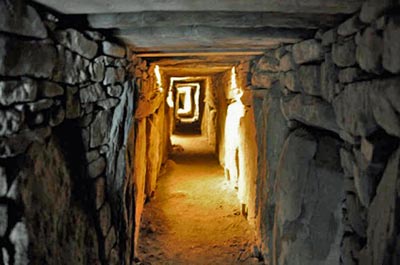
Newgrange Kerbstone K1 ~ The Entrance Stone
The Knowth site contains twenty-one passage tombs, including Tomb 1, the largest mound in the Brú na Bóinne complex. Tomb 1 has two passages back to back (the East and West Passages), each leading to a chamber. Both passages have standing stones outside them which cast shadows on their entrance stones around the Equinox. The East Passage is aligned to 83 degrees - about a week after the Spring Equinox and a week before the Autumn Equinox. However, the vast amount of art in the complex, more than one-third of all the megalithic art in Europe, suggests that this alignment is deliberate.
In mythology Knowth (Cnoc Bui) is the home of the Sovereignty goddess Bui (the Irish word for yellow), the wife of Lugh the Sun God. The Sovereignty is a goddess of the land who sleeps with the king to ensure fertility and victory in battle and is often associated with water. She takes on many names and many forms in the different myth cycles, from Queen Maeve to the Hag of Beara. Several of the sites have an association with the Sovereignty.
An association between the Sun god and a goddess of the land who sleeps with the king to bring fertility, may give us a hint of a possible meaning of the mounds to the people who built them. Could the penetration by the Sun's rays of a physical structure such as Newgrange, symbolise a marriage of heaven and Earth? Similarly, the shadow of the standing stones at Knowth, which falls across the opening to the passage around the Equinox, would seem to have the same symbolism.
Dowth
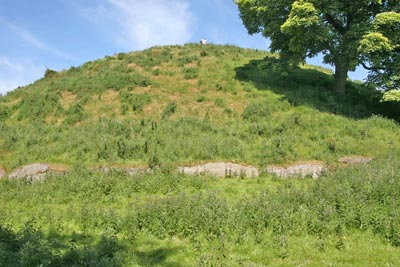
Grave Mound at Dowth
The myth of Dowth tells a different story to that of Newgrange and Knowth with Dowth appearing to represent the darker side of the Brú na Bóinne complex. The name Dowth comes from the Irish Dubad meaning 'Darkness'. Dowth is the highest of the three great monuments in Brú na Bóinne. It has suffered greatly from botched excavations, the worst of these occurring in the nineteenth century, but has never been properly excavated.
It has two passages, Dowth North and Dowth South, with Dowth South being aligned to the Winter Solstice Sunset. The winter setting Sun can enter the chamber of Dowth South from around November to February and at the Solstice, it illuminates the passage and chamber from about 2pm to 4pm. On the days around the winter solstice the rays of the setting
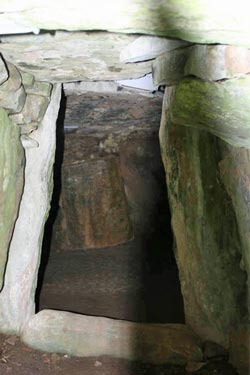
South chamber entrance at Dowth
Sun move along the left side of the passage and travel over the back stone. Like Newgrange and Knowth, Dowth is delimited by kerbstones, the most famous being Kerbstone 51 - the Stone of the Seven Suns, which has seven sun-like symbols carved on it.
The myth of Dowth abounds with celestial references. While Bressal bó-dibad was king of Ireland, a murrain came over the cattle until there were only seven cows and a bull left. Bressal called the men of Ireland from every quarter so that they might build a tower by which they could get to heaven. The story continues:
His sister came to him, and told him that she would stay the sun's course in the vault of heaven, so that they might have an endless day to accomplish their task. The maiden went apart to work her magic. Bressal followed her and had union with her: so that place is called Ferta Cuile from the incest that was committed there. Night came upon them then, for the maiden's magic was spoilt. 'Let us go hence,' say the men of Erin, 'for we only pledged ourselves to spend one day a-making this hill, and since darkness has fallen upon our work, and night has come on and the day is gone, let each depart to his place.' 'Dubad (darkness) shall be the name of this place for ever', said the maiden. So hence are Dubad and Cnoc Dubada named.
The king sleeping with his sister causing darkness during the day, is thought to represent an eclipse and there has been speculation that the seven cows could represent the Pleiades. If so, then is Dowth associated with a specific solar eclipse or does it just represent darkness in general? Monuments aligned with the Winter Solstice Sunset, like Dowth, are frequently connected with darkness unlike the lightness and rebirth stories of those with a sunrise alignment. Dowth is still dark. The electricity has been turned off and there is not even artificial light. The mound is closed to the public as it is not considered safe.
Loughcrew (3700 BCE)
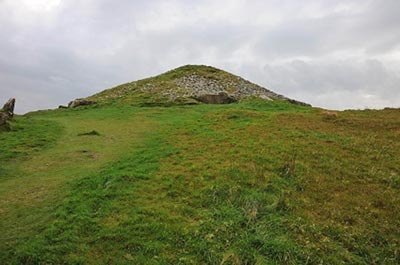
Cairn T at Loughcrew
The Loughcrew Cairns are on a ridge seventy-two kilometers north-west of Dublin and forty kilometers west of Brú na Bóinne. There are thirty-two monuments, the majority of which are on Carnbane East, Carnbane West and Patrickstown Hill. The name Carnbane comes from the Irish Cairn Bán, meaning a heap of white stones. This is thought to refer the quartz that once decorated these monuments. The cairns are identified by letters of the alphabet with Cairn T, being possibly the most widely known, due to its alignment to the Equinox sunrise.
Twice a year on the morning of the Equinox (and a day or two each side), the rising sun shines through the passage into the chamber and illuminates a large decorated stone, C8, at the back wall of the chamber. Over the course of fifty minutes, the sun traces a path across the face of C8, lighting up the carvings. The first and last symbols to receive the rays of the Sun are thought to represent the Sun itself.
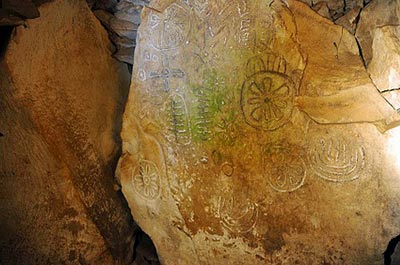
The ridge is known as Sliabh na Calliagh – The Witch's Hill. In the myth, it was created by a hag or witch who dropped the stones on the hills. This is the Hag of Beara, one of the faces of the Sovereignty, who in this story is credited with the actual creation of the cairns, at least two of which receives the rays of the Sun - Cairn T and Cairn X1 on Patrickstown Hill. She died on Patrickstown Hill where a pile of stones is known as The Hag's Grave. Just like Dowth, the Patrickstown Hill cairn is aligned to the Winter Solstice Sunset, and once again we have death rather than the birth and rebirth stories of Newgrange.
The West Coast - Carrowmore and Carrowkeel
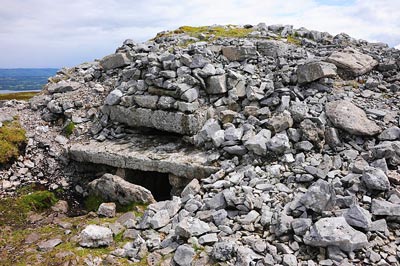
Cairn G at Carrowkeel
In terms of megalithic monuments, Sligo is the most densely populated county in Ireland. Carrowmore from the Irish 'An Cheathrú Mhór' meaning 'The Great Quarter' on the Cuil Irra Peninsula, contains the remains of thirty tombs, although archaeologists have found evidence of sixty. Most are dolmen style, with only one appearing to have the cruciform shape. Dated from somewhere between 4000 and 3500 BCE they appear to be older than the tombs on the East coast, which has challenged an earlier view that the art of tomb building in Ireland travelled from East to West.
The Carrowmore complex has a central cairn, Listoghil, which stands on the highest point of the site. Behind it rises the mountain of Knocknarea, on top of which is an ancient cairn reputed to be the tomb of the mythological Queen Maeve, one of the most powerful figures in Irish mythology. Recent scholarship has reported that Listoghil is aligned to the sunrise of 31st October with the rising Sun illuminating Queen Maeve's cairn just one minute before it reaches Listoghil. While the intentionality of this proposed alignment is still to be generally accepted, it is worthy of note that the Mound of the Hostages (c. 3000 BCE) at the Hill of Tara, shares this alignment.
Carrowkeel from the Irish 'An Cheathrú Chaol' meaning 'The Narrow Quarter' consists of fourteen cairns on a mountain top outside Sligo town. It is dated from 3400 to 3100 BCE. The tombs are on the highest and north-facing summits, oriented towards the Cuil Irra Peninsula, and tend to be at the cliff edge. One of the Carrowkeel's cairns, Cairn G, is aligned to the Summer Solstice Sunset and contains the only known roofbox outside of Newgrange.
Conclusion
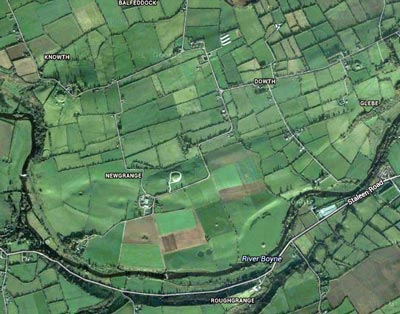
Brú na Bóinne, the region in the Republic of Ireland where these sites are found. Designated a World Heritage site by UNESCO in 2013 as 'Archaeological Ensemble of the Bend of the Boyne.'
Many of the ancient myths that were handed down in the oral tradition were lost when Christianity came to Ireland. From what we have left it would appear that it is the sites with solar alignments that are associated with the gods and the heroes from the four mythological cycles. These are the sites that continue to attract visitors the world over.
Twice a year before the Equinox sunrise, crowds of people make the long and often slippery climb up to the top of Carnbane East in the dark, to enter Cairn T and witness the rays of the rising Sun travel across the backstone (C8). The eve of the Winter Solstice Sunset each year, sees a group of people gather outside Dowth, although they cannot enter the passage. However it is Newgrange, the mound that plays the biggest role in the myths we have left, that attracts people from all over the world.
Each year there is a lottery, the prize being the chance to stand in the inner chamber and watch the Winter Solstice Sunrise light up the chamber for seventeen minutes, weather permitting. In 2013 30,000 people entered the draw, each one of them having visited Newgrange during the year. Some of us have been trying for years.
Bibliography
Anon. "The Cuchulainn Cycle." Sacred-Texts, http://www.sacred-texts.com/neu/celt/rac/rac10.htm.
Bergh, Stefan. Landscape of the Mountains; A study of the passage tombs in the Cuil irra region, Co. Sligo, Ireland, Doctoral Dissertation 1995, Dept. Of Archaeology, University of Stockholm
Brennan, Martin. The Stars and the Stones : Ancient Art and Astronomy in Ireland (London: Thames and Hudson, 1983).
Cooney, Gabriel. "The Passage Tomb Phenomenon in Ireland." Archaeology Ireland 11, no. 3, Supplement: Brú na Bóinne (1997): 7-8.
Cooney, Gabriel. 'Newgrange – a view from the platform', Antiquity 80 (2006): 697-710
Gregory, Lady Agusta. Lady Gregroy's Complete Irish Mythology (London: Bounty Books, 2004[1902, 1904]).
McMann, Jean. Loughcrew: The Cairns (Oldcastle: After Hours Books, 2005 (1993)
Massey, Eithne. Legendary Ireland: A Journey through Celtic Places and Myths (Dublin: The O'Brien Press, 2003).
Meehan, Padraig. 'A Possible Astronomical Alignment marking Seasonal Transitions at Listoghil, Sligo, Ireland', Internet Archaeology 32, September 2012.
O'Brien, Tim. Light Years Ago : A Study of the Cairns of Newgrange and Cairn T Loughcrew Co. Meath Ireland (Monkstown, Co. Dublin: Black Cat Press, 1992).
O'Kelly, Michael. Newgrange: Archaeology, Art and Legend (London: Thames & Hudson, 1982).
Ruggles, Clive. Ancient Astronomy (Santa Barbara, CA: ABC Clio, 2005).
Sheridan, Alison. "Megaliths and Melalomania: An Account, and Interpretation, of the Development of Passage Tombs in Ireland." The Journal of Irish Archaeology 3, no. 1985/1986 (1985): 17-30.
The Loughcrew Hills and Passage Tomb Complex', Field Guide No. 29, North Meath (Dublin: Irish Quaternary Association, 2011)

